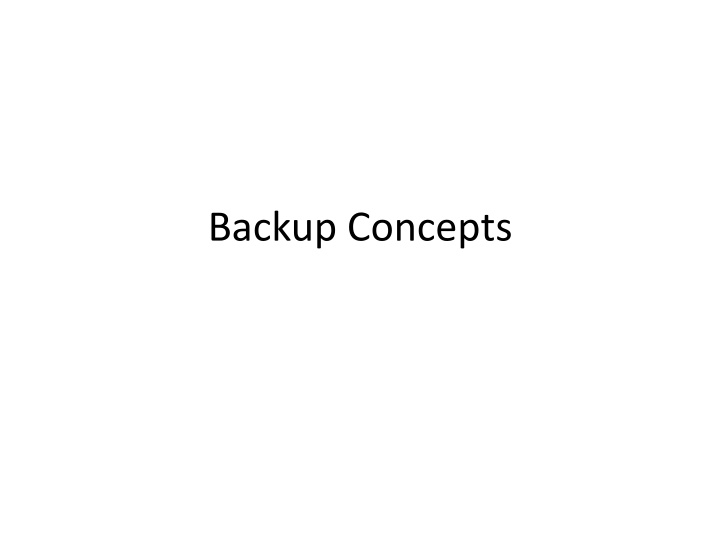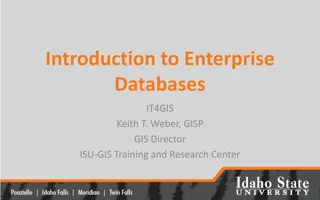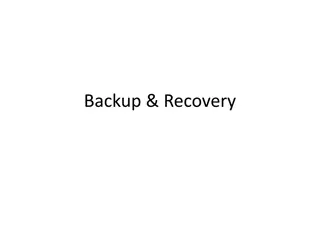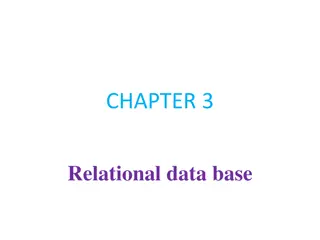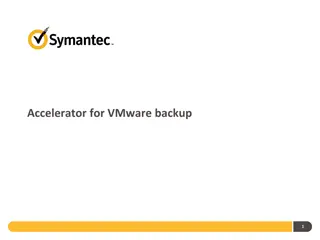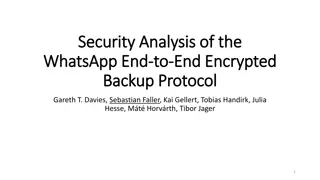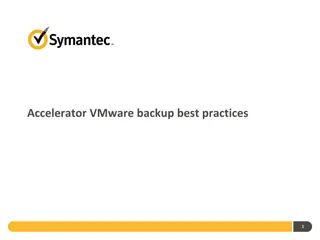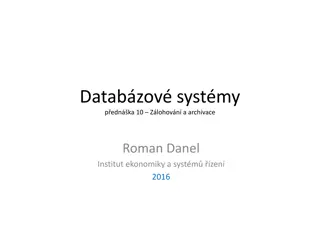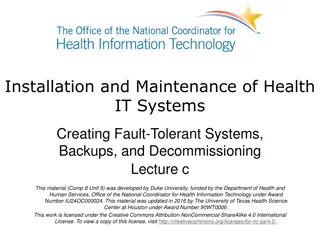Introduction to Backup and Recovery Procedures in Databases
Backup and recovery procedures are essential for protecting databases against data loss. This chapter covers fundamental concepts and strategies for designing a backup plan, including physical and logical backups, consistent and inconsistent backups, and the importance of whole database backups.
Download Presentation

Please find below an Image/Link to download the presentation.
The content on the website is provided AS IS for your information and personal use only. It may not be sold, licensed, or shared on other websites without obtaining consent from the author.If you encounter any issues during the download, it is possible that the publisher has removed the file from their server.
You are allowed to download the files provided on this website for personal or commercial use, subject to the condition that they are used lawfully. All files are the property of their respective owners.
The content on the website is provided AS IS for your information and personal use only. It may not be sold, licensed, or shared on other websites without obtaining consent from the author.
E N D
Presentation Transcript
Introduction Backup and recovery procedures protect your database against data loss and reconstruct the data, should loss occur. The reconstructing of data is achieved through media recovery, which refers to the various operations involved in restoring, rolling forward, and rolling back a backup of database files. This chapter introduces concepts fundamental to designing a backup strategy.
Introduction to Backup A backup is a copy of data (such as the control file, archived redo logs and datafiles) A backup is a safeguard against unexpected data loss and application errors. Backups are divide into: Physical backups Logical backups
Introduction to Backup Physical backups: Copies of physical database files and storing database information to some other location, whether on disk or some offline storage such as tape. Two ways to perform physical backup: Recovery Manager (RMAN) utility. Operating system utilities.(user-managed backup) Logical backups: Contain logical data (for example, tables and stored procedures) Extract with an Oracle utility (Export utility) and stored in a binary file. Logical backups used to supplement physical backups. Physical backups are the foundation of any sound backup and recovery strategy. Logical backups are a useful supplement to physical backups in many circumstances but are not sufficient protection against data loss without physical backups.
Consistent and Inconsistent Backups Consistent backups: The files being backed up contain all changes up to the same system change number (SCN). The files in the backup contain all the data taken from a same point in time. To make a consistent whole database backup: shut down the database with the NORMAL, IMMEDIATE, or TRANSACTIONAL options and make the backup while the database is closed. The important point is that you can open the database after restoring a consistent whole database backup without needing recovery because the data is already consistent consistent whole database backup is valid with NOARCHIVELOG and ARCHIVELOG mode
Consistent and Inconsistent Backups Inconsistent backups: The files being backed up do not contain all the changes made at all the SCNs (some changes are missing). This can occur because the datafiles are being modified as backups are being taken If the database must be up and running 24 hours a day, seven days a week, then you have no choice but to perform inconsistent backups of the whole database. Online backup This requires that you run your database in ARCHIVELOG mode.
Whole Database Backups Backup of every datafile in the database, plus the control file. Whole database backups can be taken in either ARCHIVELOG or NOARCHIVELOG mode. Before performing whole database backups, however, be aware of the implications of backing up in ARCHIVELOG and NOARCHIVELOG modes. A whole database backup is either a consistent backup or an inconsistent backup.
Tablespace Backups Backup of the datafiles that constitute the tablespace. For example, if tablespace users contains datafiles 2, 3, and 4, then a backup of tablespace users backs up these three datafiles. Tablespace backups, whether online or offline, are valid only if the database is operating in ARCHIVELOG mode.
Datafile Backups Backup of a single datafile. Datafile backups are valid in ARCHIVELOG databases. The only time a datafile backup is valid for a database in NOARCHIVELOG mode is if: Every datafile in a tablespace is backed up. You cannot restore the database unless all datafiles are backed up. The datafiles are read only or offline-normal.
Errors and Failures Requiring Recovery from Backup only two typically require DBA intervention and media recovery: media failure, and user errors. Other failures may require DBA intervention to restart the database (after an instance failure) or allocate more disk space but these situations will not generally cause data loss or require recovery from backup. User Error User errors occur when, either due to an error in application logic or a manual mis-step, data in your database is changed or deleted incorrectly. Media Failure is the failure of a read or write of a disk file required to run the database, due to a physical problem with the disk such as a head crash.
Complete, Incomplete and Point-In- Time Recovery Complete recovery is recovering a database to the most recent point in time, without the loss of any committed transactions. Generally, the term "recovery" refers to complete recovery. We need to perform complete recovery if media failure occur incomplete recovery, also known as point-in-time recovery, the goal is to restore the database to its state at some previous target SCN or time. to undo the effect of a user error, such as dropping or deleting the contents of a table, you may want to return the database to its contents before the delete occurred. if you have to perform a recovery and discover that you are missing an archived log covering time between the backup and failure. You should run OPEN RESETLOGS after incomplete recovery, to reset redo logs to 1 To perform complete and incomplete recovery, administrator must restore the backup manually. Then, the system perform the recovery
Crash Recovery The crash recovery process is a special form of recovery, which happens the first time an Oracle database instance is started after a crash (or SHUTDOWN ABORT). involve two distinct operations: rolling forward the current, online datafiles by applying both committed and uncommitted transactions contained in online redo records rolling back changes made in uncommitted transactions to their original state. Oracle applies the redo automatically: no user intervention is required to supply redo logs. Archived logs are never used during crash recovery, and datafiles are never restored from backup.
Online datafiles and redo logs
Backup and Recovery with RMAN RMAN gives you access to several data backup and recovery techniques and features not available at all with user-managed backup and recovery Incremental backups, which provide more compact backups (storing only changed blocks) and faster datafile media recovery (reducing the need to apply redo during datafile media recovery) Block media recovery, in which a datafile with only a small number of corrupt data blocks can be repaired without being taken offline or restored from backup Unused block compression, where RMAN can in some cases skip unused datafile blocks during backups Binary compression, which uses a compression mechanism integrated into the Oracle database server to reduce the size of backups Encrypted backups, which uses encryption capabilities integrated into the Oracledatabase to store backups in an encrypted format
RMAN and User-Managed Backups backup created through RMAN can be: Image copies: exact duplicate of a datafile, control file, or archived log. restore them as-is without performing additional processing by using either operating system utilities(user-managed backup) or RMAN. Backup sets: backup in a proprietary format that consists of one or more physical files called backup pieces. contain more than one database file, and it can also be backed up using special processing
Control file Backups Instruct RMAN to automatically backup the control file whenever you run backup jobs. Use the command CONFIGURE CONTROLFILE AUTOBACKUP Methods to manual backups of the control file: The RMAN BACKUP CURRENT CONTROLFILE command makes a binary backup of the control file, as either a backup set or an image copy. The SQL statement ALTER DATABASE BACKUP CONTROLFILE makes a binary backup of the control file. The SQL statement ALTER DATABASE BACKUP CONTROLFILE TO TRACE exports the control file contents to a SQL script file.
